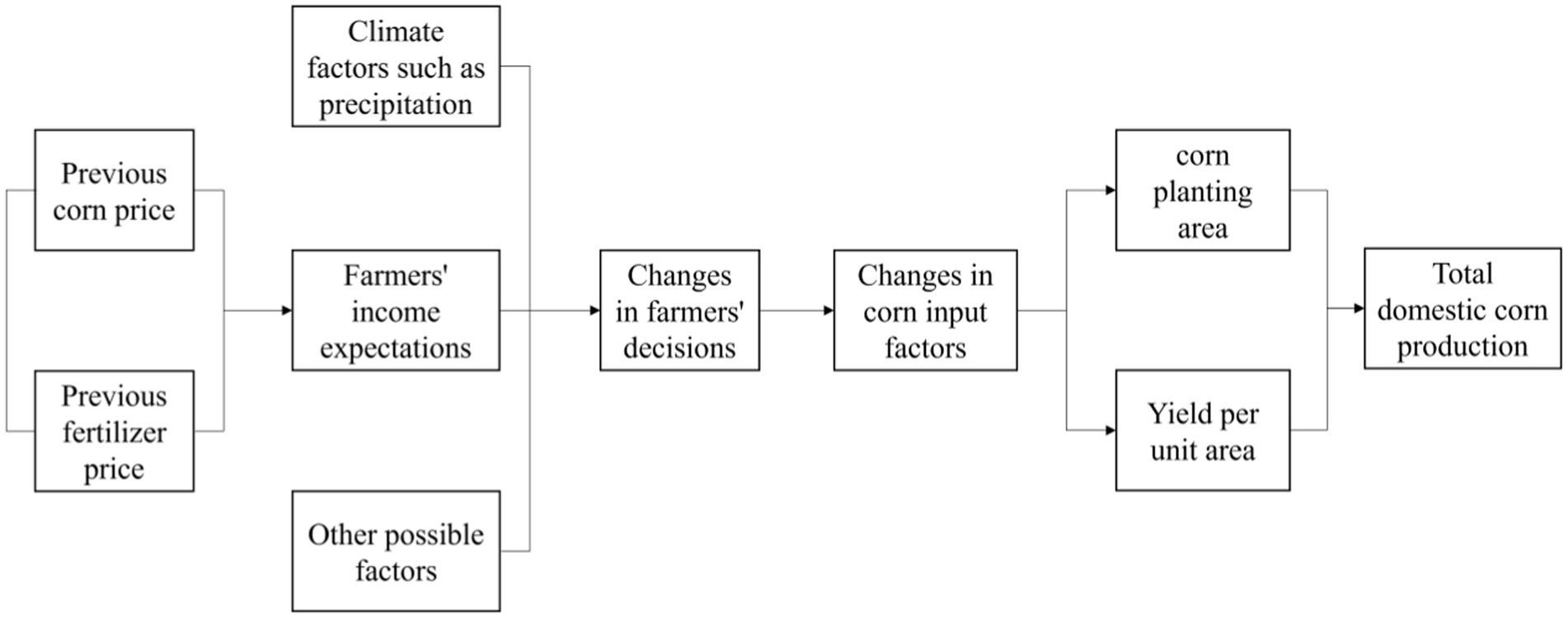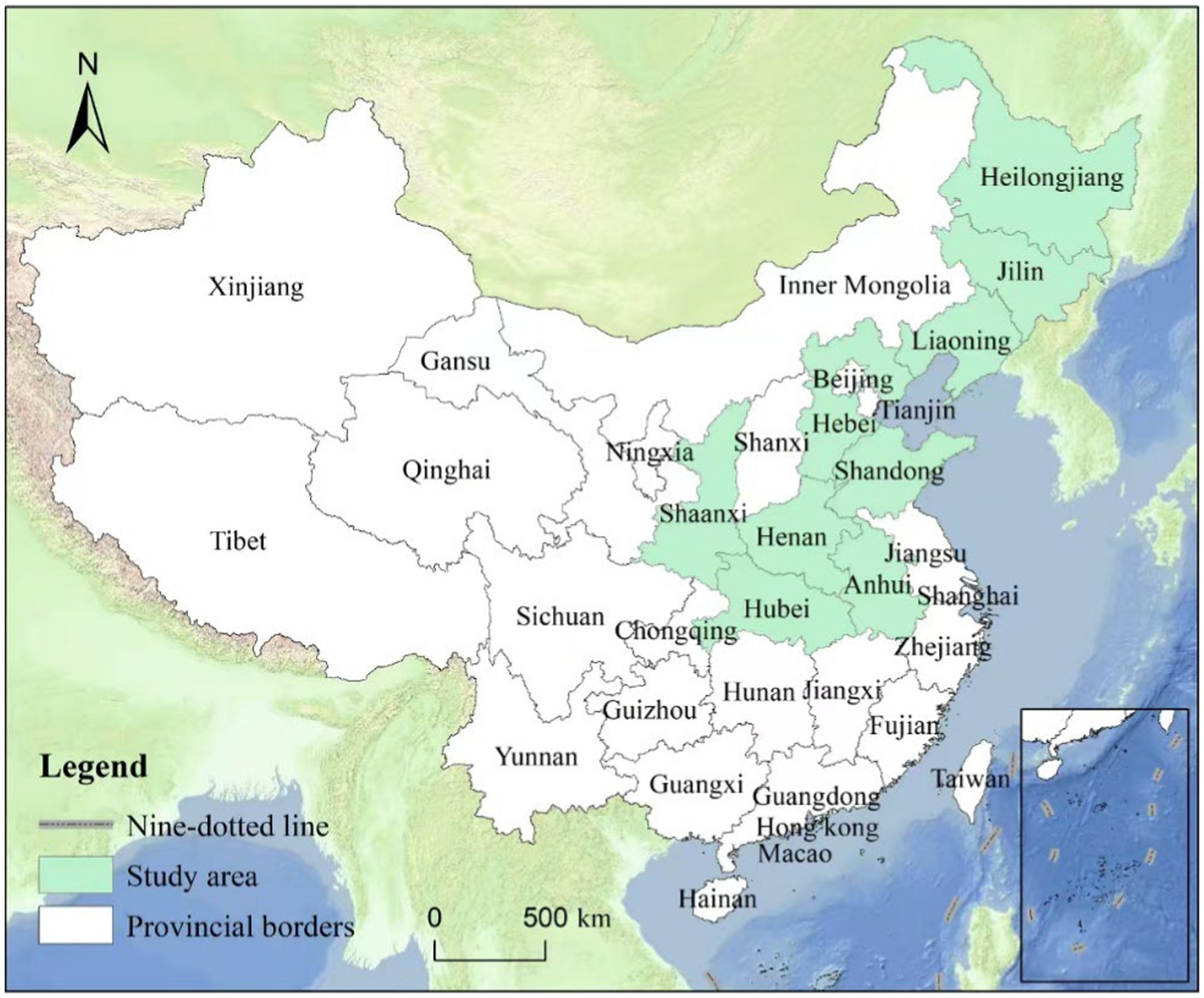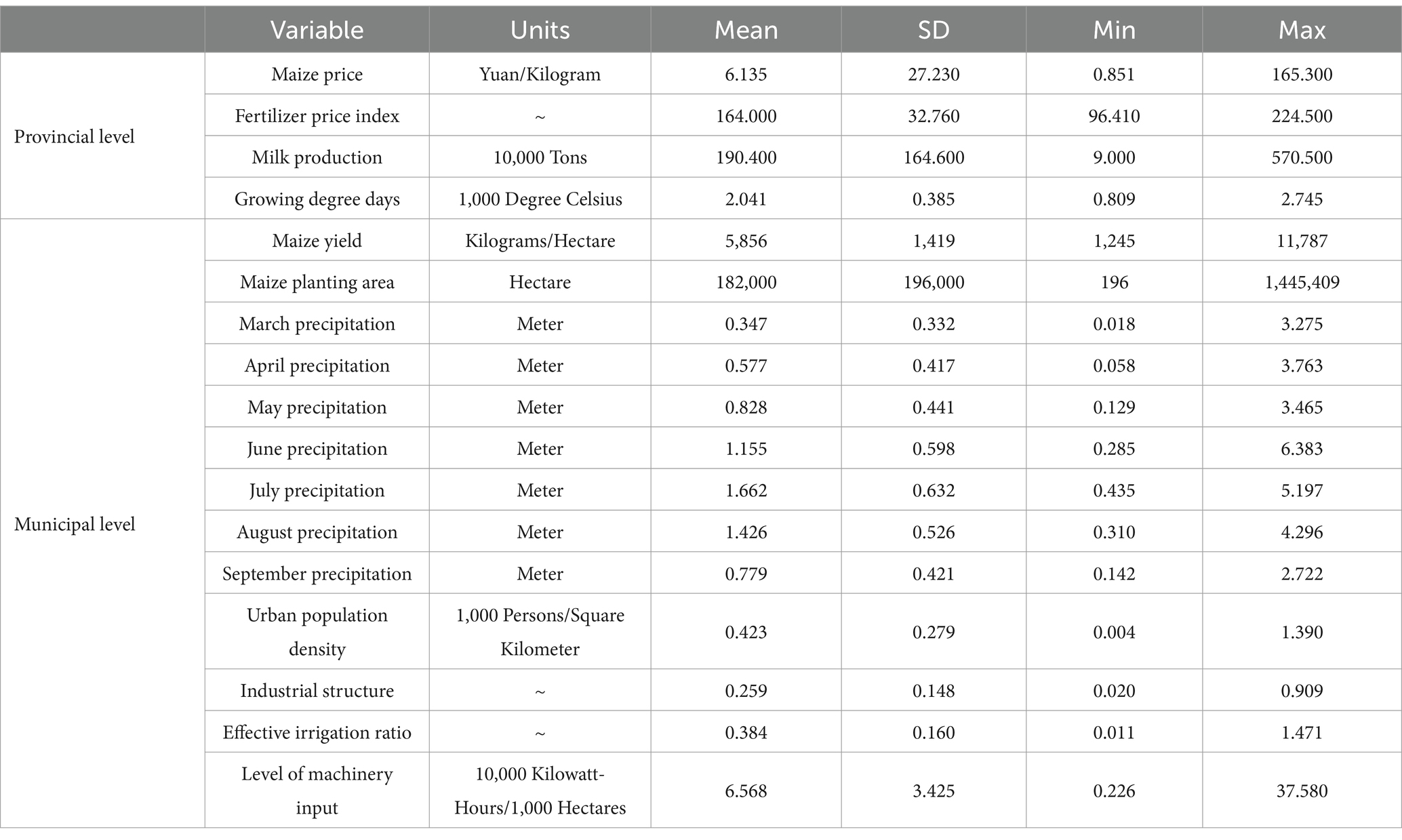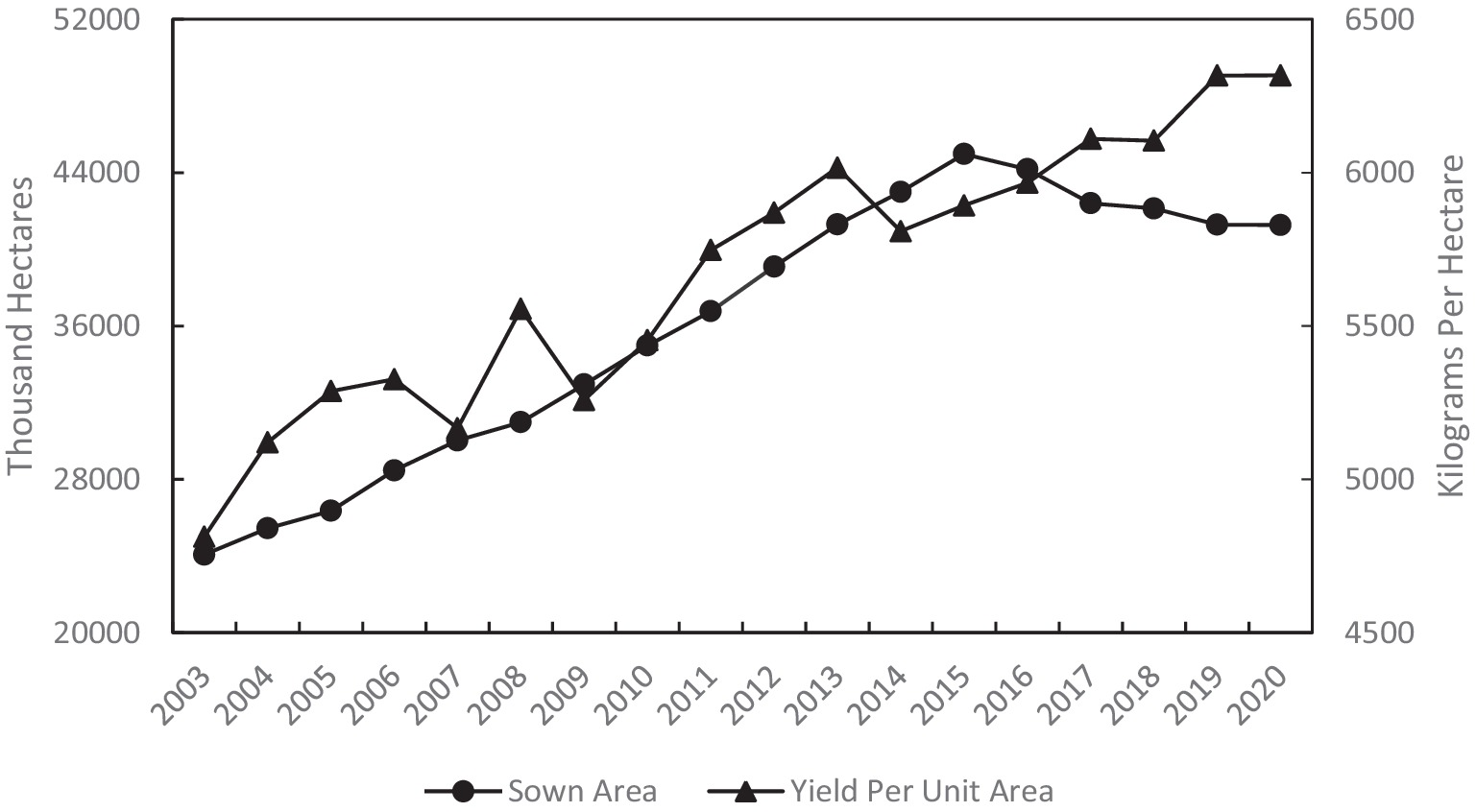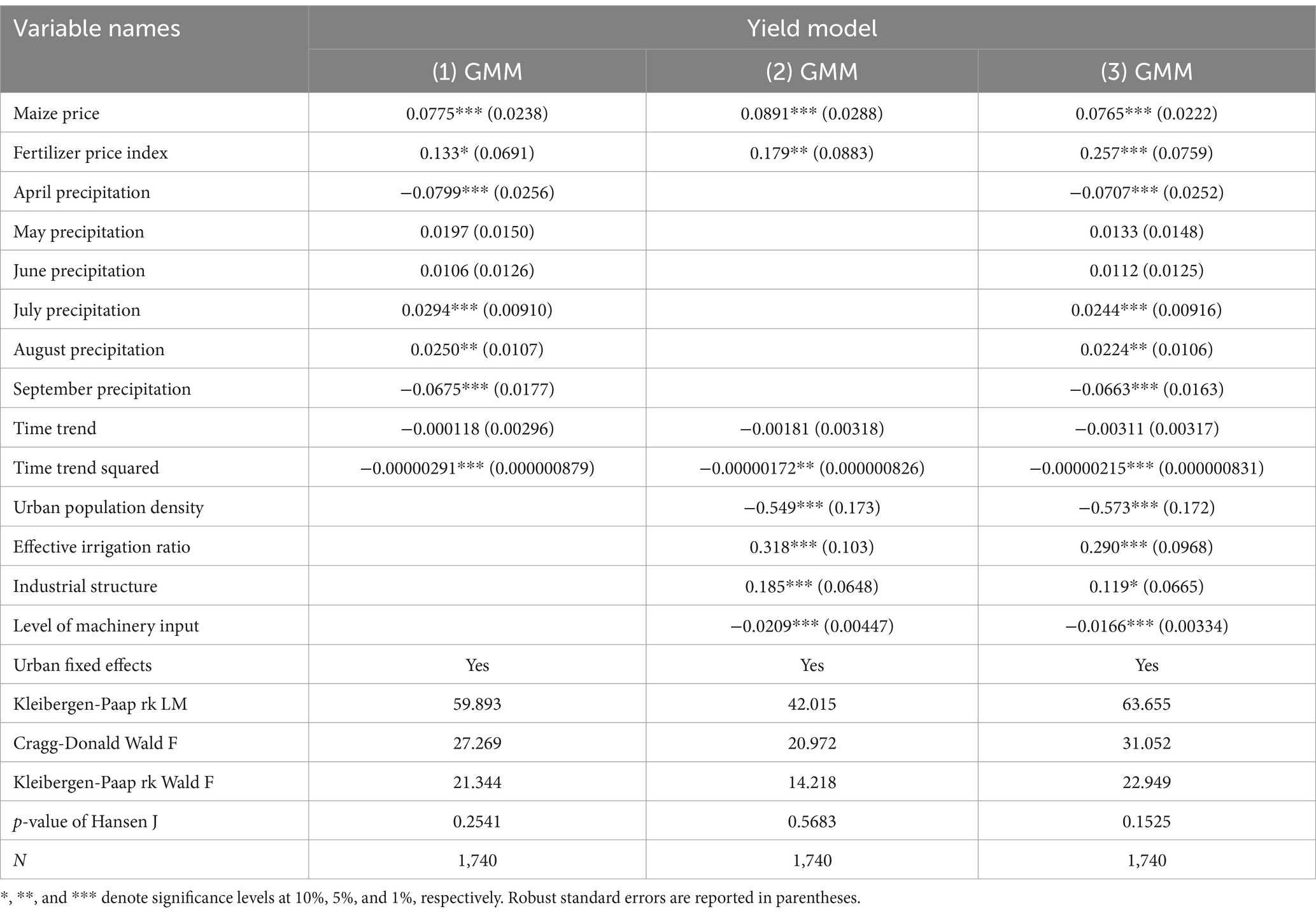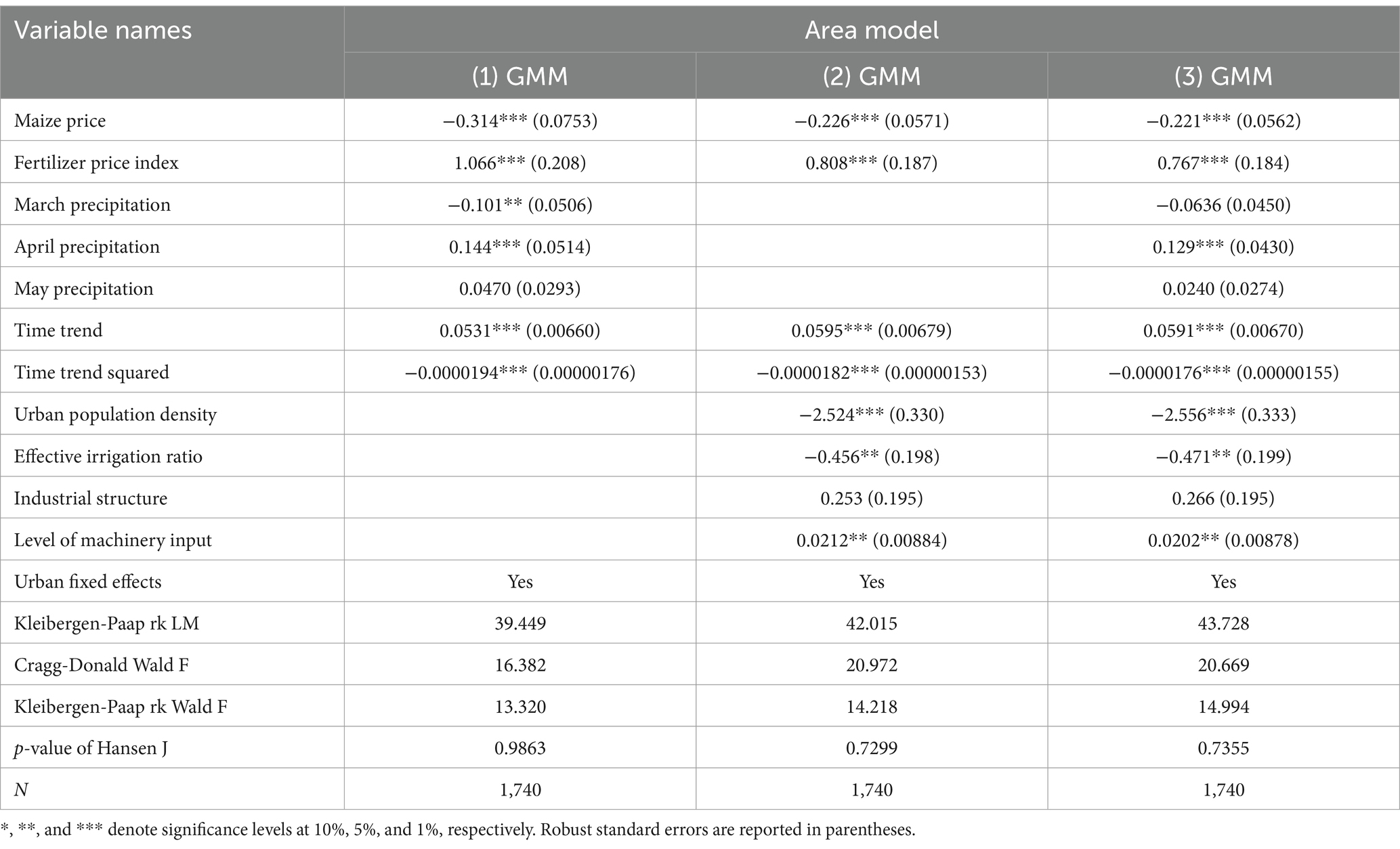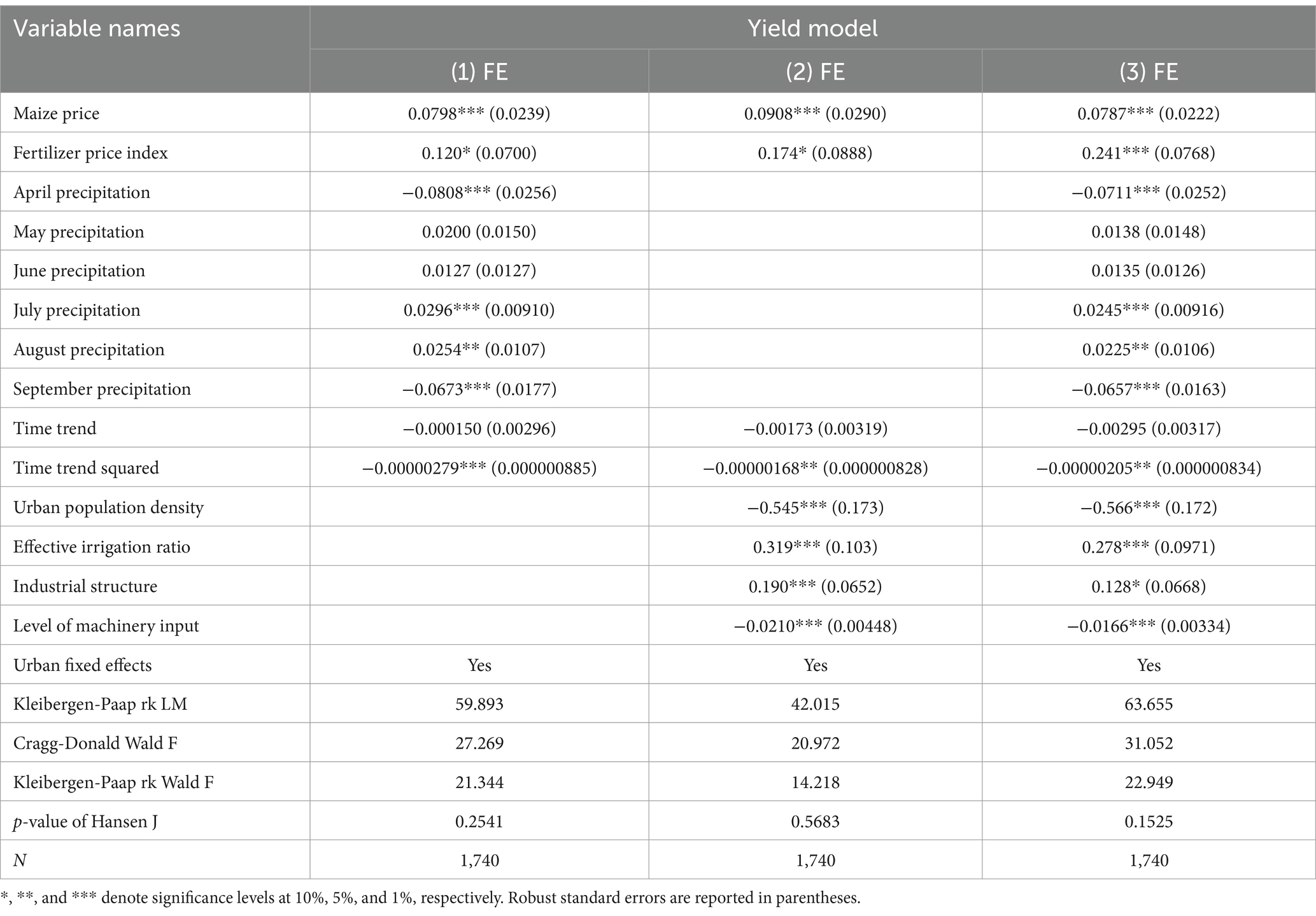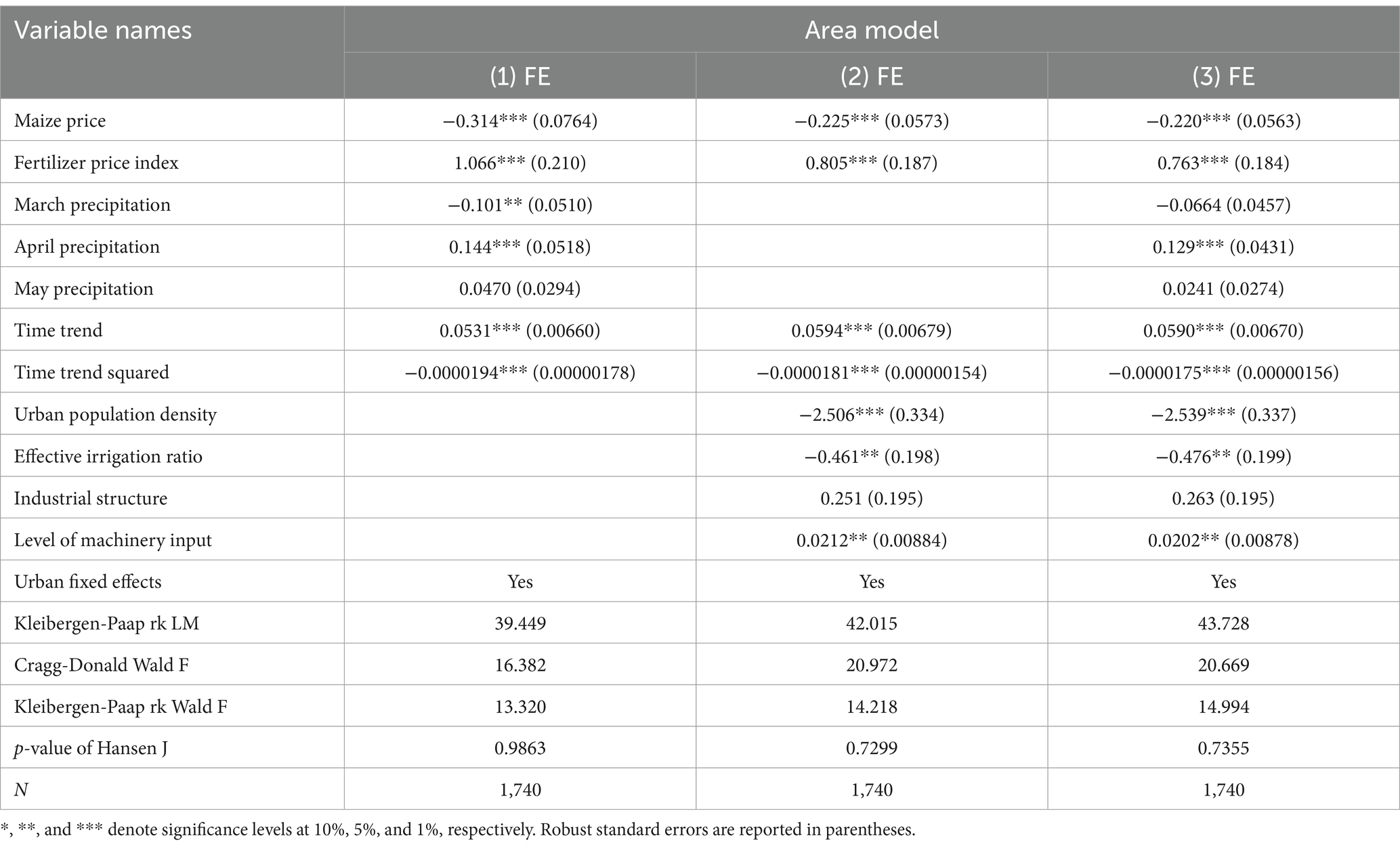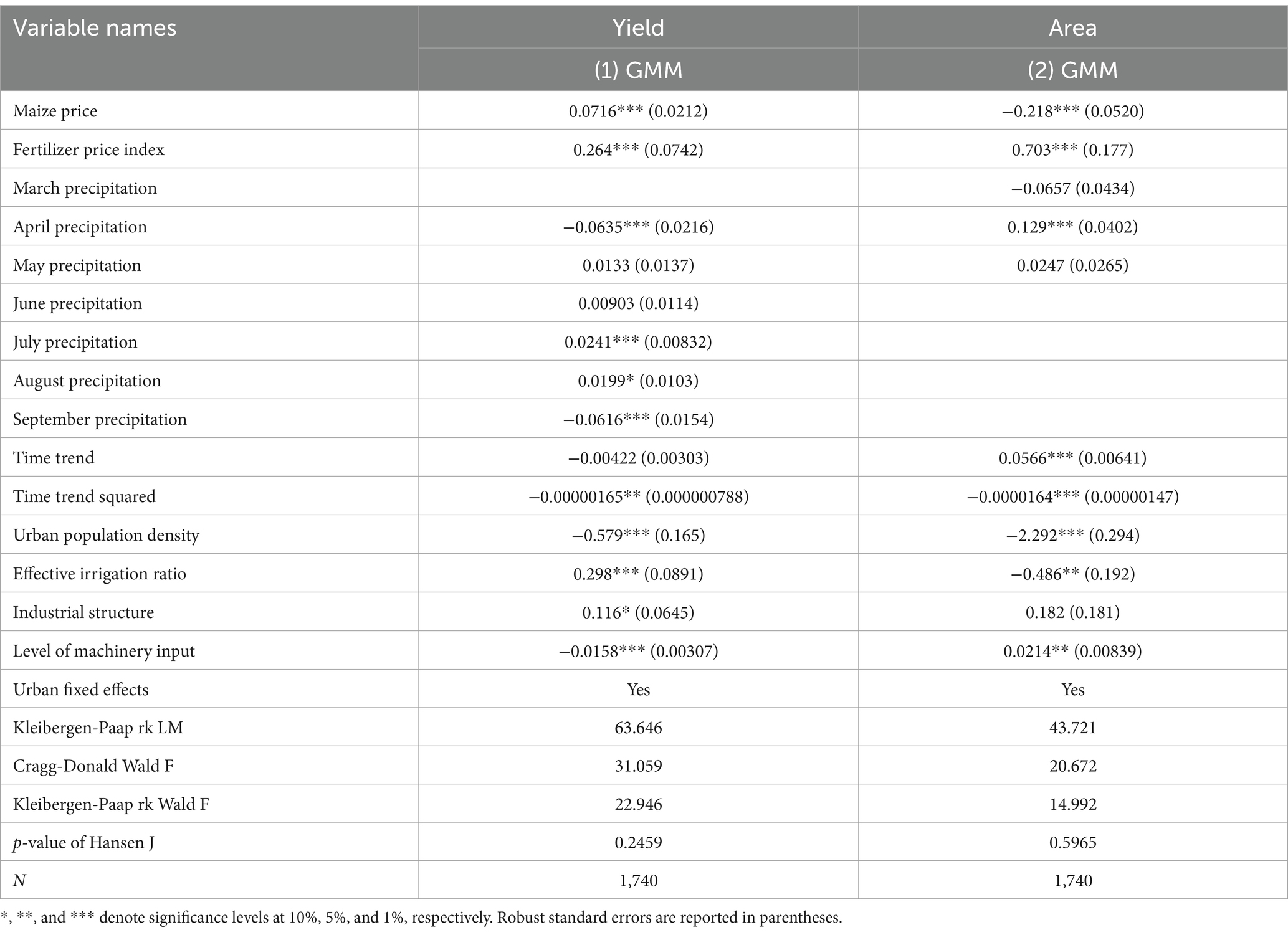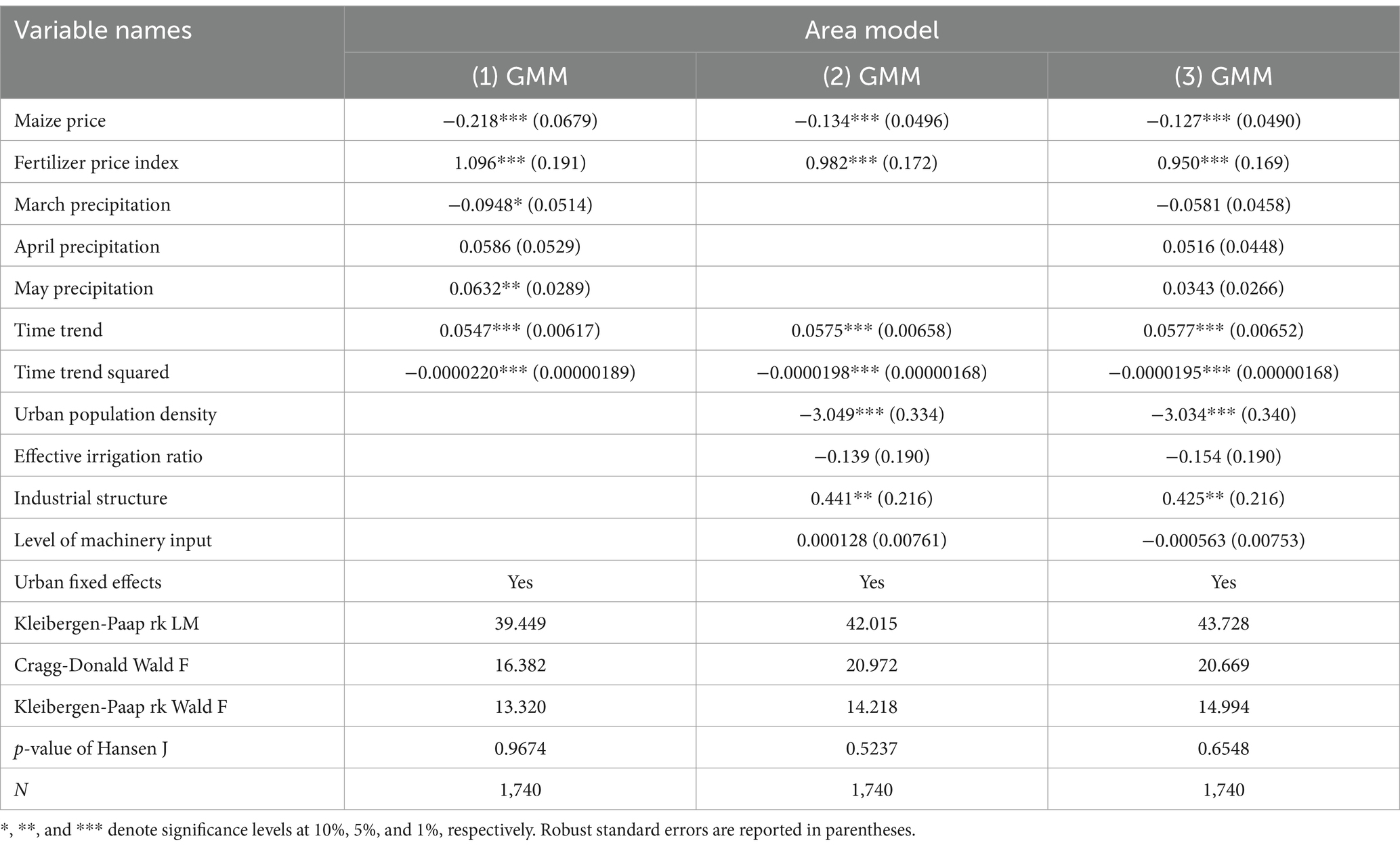- 1Institute of Agricultural Economics and Development, Chinese Academy of Agricultural Sciences, Beijing, China
- 2Agricultural Information Institute, Chinese Academy of Agricultural Sciences, Beijing, China
Against the backdrop of intensifying climate change, maize, as a critical global food and feed crop, plays a pivotal role in ensuring food security and promoting sustainable agricultural development. This study utilizes panel data from 116 prefecture-level cities across nine provinces in China from 2003 to 2019 to analyze the dynamic impacts of maize prices, fertilizer price indices, and monthly precipitation on maize planting area and yield, employing fixed-effects models and the GMM estimation method. The empirical model incorporates key variables such as the previous year’s maize price, fertilizer price index, precipitation from March to May (affecting planting area), and monthly precipitation from April to September (affecting yield), while also accounting for control variables including urban population density, effective irrigation rate, industrial structure, and mechanization level. The results indicate that the previous year’s maize price and fertilizer price index exert significant positive effects on yield, while the fertilizer price index positively influences planting area, and maize price shows a significant negative effect on planting area. The impact of precipitation varies by month: precipitation in July and August enhances yield, whereas precipitation in April and September negatively affects yield. Additionally, March precipitation has a significant negative effect on planting area, while April precipitation positively affects planting area. Robustness tests further confirm the reliability of these findings. Moreover, the study identifies a diminishing marginal effect of agricultural technological progress and proposes policy recommendations, including optimizing irrigation infrastructure, promoting stress-resistant crop varieties, and fostering technological innovation. These findings provide theoretical insights and empirical support for improving maize production efficiency and ensuring food security.
1 Introduction
Maize is a critical global food and feed crop, and China is one of the world’s largest producers and consumers of maize (Su, 2024; Wang et al., 2022). Within China’s agricultural system, maize ranks alongside rice and wheat as one of the three major staple grains, playing a vital role in ensuring food security. Maize has consistently accounted for a high proportion of the total agricultural output value, particularly in Northeast China and the Huang-Huai-Hai region, where maize planting areas exceed 50% of the total grain crop area, making it a pillar of the local agricultural economy. Maize is not only an important supplement to food production but also the primary source of feed grain for the livestock sector, accounting for over 60% of national feed grain consumption (Wang et al., 2022). Its stable supply is crucial for the sustained production of meat and dairy products. Due to its suitability for mechanized and large-scale cultivation, maize has become a key sector in China’s agricultural modernization, significantly promoting the dissemination of agricultural technologies and improvements in production efficiency.
In recent years, driven by population growth and economic development, maize demand has continued to rise. Between 2013 and 2023, China’s maize production increased by 46.9%, growing from 209 million tons to 307 million tons (Wang et al., 2021; Liu and Liu, 2023). The growth rate of maize-sown area has outpaced that of other staple crops, but this expansion has also revealed structural contradictions such as inventory surpluses, insufficient supply of high-quality maize, and deepening dependence on imports (Liu and Liu, 2023; Ye et al., 2024; Wang et al., 2024). Currently, maize has become China’s second-largest imported agricultural product, with imports reaching 27.13 million tons in 2023, exacerbating market risks due to over-quota imports (Si et al., 2025). The 2009 natural disaster in Northeast China triggered China’s transition from a net exporter to a net importer of maize, and dependence on the international market has continued to intensify since then (Song and Wei, 2024).
Against the backdrop of climate change and global geopolitical instability, the strategic significance of maintaining a stable maize supply for national food security and livestock sector development has greatly increased (Song et al., 2020). Price volatility and precipitation uncertainty in maize production present challenges similar to those faced by other staple crops. Based on panel data from 116 prefecture-level cities between 2003 and 2019, this study quantitatively analyzes the combined effects of maize prices, fertilizer price indices, and monthly precipitation on planting area and yield. It reveals the vulnerabilities of the food production system under the dual pressures of market and climate change, as well as the need for adaptive adjustments. The findings are not only applicable to the maize system in China but also provide important references for addressing common challenges in the construction of sustainable global food systems.
Agriculture is one of the sectors most sensitive and vulnerable to climate change (Qian et al., 2014). Some scholars have combined crop models with tools such as Global Climate Models (GCM) and Regional Climate Models (RCM) to analyze the impacts of climate change on agricultural production (Jin, 1991; Lin et al., 1997; Gao, 1991). The impacts of climate change on maize production are primarily reflected in planting area and yield, with key driving factors including precipitation, temperature, and extreme weather events. Changes in precipitation patterns and droughts directly affect the stability of maize yields. Chen and Su (2022) found that precipitation in major maize production areas of Henan Province exhibits nonlinear effects on maize yields, with excessive or insufficient rainfall during the silking stage leading to yield reductions. Ma et al. (2015) indicated that drought significantly reduces maize yields in Hebei, while an increase of 10 millimeters of precipitation can boost yield by 0.21%. Ray et al. (2015) demonstrated that one-third of global maize yield variability can be attributed to climate variability. Temperature is another critical factor influencing maize yield. Studies by Mao et al. (2022) and Cui et al. (2011) showed that moderate increases in temperature can extend the growing period and enhance yields in North China and Northeast China, while high temperatures during the silking and grain-filling stages have significant negative effects. International research, such as Zhao et al. (2017), pointed out that global warming has already led to stagnation in maize yield growth in some regions, particularly in tropical and subtropical areas. Climate change also alters the climatic suitability of land, thereby influencing the spatial distribution of maize planting areas and total production. Research by Ge et al. (2015), based on the GAEZ model, suggested a general decline in maize suitability in China, although the Northeast Plain has seen improved suitability due to rising temperatures and better hydrothermal conditions, while North China has faced constraints from warming and drying trends. Nationwide, climate change has led to a trend of “potential reduction–regional divergence” in maize production (Zhu, 2024), with yields increasing in Northeast China but growth slowing or even declining in North China due to intensified extreme weather events. Regional disparities and adaptation strategies have become focal points of research. In Northeast China, rising temperatures and improved precipitation have led to positive trends in planting area and yield (Ge et al., 2015; Cui et al., 2011). However, in North China, worsening warming and drying trends have progressively deteriorated production conditions (Mao et al., 2022), making adaptation strategies especially important. Chen and Zhou (2022) emphasized that irrigation technologies can effectively mitigate the effects of insufficient precipitation, while Cairns et al. (2013) highlighted that the development of drought-tolerant and heat-resistant maize varieties is critical for enhancing maize resilience. Moreover, policy support and farmers’ perceptions of climate risks (Ma et al., 2015; Adeagbo et al., 2021) also play important roles in improving climate adaptation capacity.
Price is an important market signal regulating agricultural production, influencing maize planting area, yield, and total output through various pathways. Existing studies have systematically reviewed the mechanisms of price volatility, regional differences in response, and the role of policy interventions, revealing the comprehensive impact of prices on maize production systems. First, price fluctuations have both direct and indirect effects on maize production. Xiao et al. (2017) found that international grain price fluctuations have a dynamic temporal relationship with China’s maize production: the two were negatively correlated before 2007 and became positively correlated afterward, likely due to the implementation of price support policies and changes in international market transmission mechanisms. Zhang (2021) pointed out that climate change and subsidy policies significantly affect maize yields and prices, guiding farmers’ adjustments in planting areas. Second, land transfers and social networks strengthen price signals through economies of scale and risk-sharing effects. Third, the impacts of prices on maize production vary significantly across regions. Geng and Gao (2021) found that maize price elasticity in Shandong Province is relatively low both in the short and long term, with slow responses of planting area to price changes, constrained by factors such as net returns of alternative crops and disaster rates. Fang and Yang (2016), using a supply response model, showed that after the implementation of the temporary purchase and storage policy in 2008, maize price sensitivity in Northeast China increased significantly, leading to large increases in both planting area and yield, whereas responses in other regions were weaker. This reflects the moderating role of regional economic and agricultural infrastructure conditions in price effects. Fourth, policy interventions have strengthened the regulatory function of prices on maize production. Wang (2021) noted that reforms to price support policies have enhanced the stability of price signals through transmission and expectation effects, improving farmers’ adaptability in production decisions. Lü and Li (2020) predicted that even if maize planting areas reach historical highs, China’s maize supply–demand situation will remain tight in the long term, and prices may rise moderately. In summary, policy optimization measures such as import quota management and adjustments to consumption structures are necessary to further improve the maize production and supply system.
Regarding the research on the impacts of prices and climate on maize production, existing studies mostly explore these issues from a macro-qualitative or simple quantitative perspective. Some scholars, when analyzing factors affecting crop planting areas, primarily focus on price variables and economic factors while neglecting climate factors (Choi and Helmberger, 1993; Houck and Gallagher, 1976; Lyons and Thompson, 1981; Menz and Pardey, 1983). Others consider only the impact of climate on maize production without comprehensively analyzing the joint effects of prices and climate. Wang (2018) used the Nerlove model and GMM methods to analyze the effects of prices and climate on maize production but relied on provincial-level data, with overly aggregated descriptions of variables such as precipitation and temperature, limiting the persuasiveness of the results. To simultaneously account for price and climate factors, some researchers have adopted the Ricardian approach (Schlenker and Roberts, 2009; Mendelsohn et al., 1994), but this method, based on cross-sectional data, assumes constant input and output prices over time (Darwin, 1999; Schlenker and Roberts, 2009), which imposes certain limitations. On the other hand, some studies, when using econometric methods to explore crop production factors, often failed to address the endogeneity between crop input and output prices due to the limitations of econometric techniques at the time, potentially leading to biased results (Choi and Helmberger, 1993; Houck and Gallagher, 1976; Kaufmann and Snell, 1997). For instance, Miao et al. (2016) analyzed the effects of prices and climate on maize and soybean yields and planting areas in the United States using data from 926 counties between 1977 and 2007. Given that the U.S. is the world’s largest maize producer and exporter, clarifying these effects holds significant implications for the global food market.
Based on panel data from 116 prefecture-level cities in China spanning 2003 to 2019, this study systematically examines the combined effects of price and climate factors on maize production. Compared with Miao et al. (2016), who controlled only for urban population density, this study additionally incorporates key variables such as effective irrigation rate, industrial structure, and mechanization input, significantly enhancing the unbiasedness of model estimation. The main innovations of this study are as follows: (1) By integrating economic variables (maize prices, fertilizer price indices) with natural factors (monthly precipitation), the study constructs a multidimensional impact mechanism framework, overcoming the limitations of single-dimensional analysis. It reveals the synergistic mechanisms between price and climate factors, providing a new paradigm for agricultural decision-making. (2) Through a time-series analysis of monthly precipitation, the study quantifies the differentiated impacts of climatic factors during critical growth stages such as sowing, silking, and grain filling. This finding offers a scientific basis for formulating climate change adaptation strategies. (3) Using panel data from 116 prefecture-level cities across nine provinces—covering approximately 85% of China’s major maize production areas—the study ensures strong spatial and temporal representativeness of its findings.
Aside from the introduction, the structure of the paper is organized as follows: Section 2 presents the theoretical framework; Section 3 covers variable selection, model specification, and data sources; Section 4 discusses the empirical results and analysis; and Section 5 concludes with the main findings and discussion.
2 Theoretical foundation
The acceleration of agricultural marketization has made price the core factor influencing farmers’ production decisions, directly regulating input allocation and crop selection through expected returns (Han, 1995). The improvement of market mechanisms has led farmers’ decision-making to become increasingly rational, while the government stabilizes fluctuations in the maize and fertilizer markets through price intervention policies to ensure income and input stability (see conceptual framework in Figure 1).
2.1 Impacts of maize prices on farmers’ decisions and government interventions
As a government-regulated commodity, maize prices, although subject to administrative controls, still exert significant guidance over planting area and yield decisions (Qiao, 2017). Expectations of price increases drive the expansion of planting areas and upgrading of inputs (e.g., adoption of high-efficiency production materials and superior varieties), thereby enhancing yield. However, blind expansion into low-yield lands or extensive management practices may offset potential yield gains. During periods of sharp price fluctuations, the government employs a dual-track regulatory approach: subsidies may be reduced or crop diversification encouraged when prices rise, while market support procurement programs or direct subsidies are initiated when prices fall. Ultimately, adjustments in maize production reflect a market–policy equilibrium, with the net effect determined by the relative strength of market forces and policy interventions.
2.2 Impacts of input price fluctuations and government interventions
Fertilizer price fluctuations significantly impact the scale and efficiency of maize production through cost transmission mechanisms. Rising fertilizer prices produce dual effects: they may suppress yield through reduced fertilizer use or drive technological upgrading (e.g., adoption of high-efficiency varieties, precision fertilization) to improve input productivity. Given maize’s high dependency on fertilizers, fertilizer price increases can trigger a shift in planting area allocation; however, the expansion onto marginal lands often offsets potential yield improvements. The government’s policy toolkit includes: (i) direct subsidies to alleviate cost pressures; (ii) promotion of technologies such as efficient fertilization and the use of biofertilizers; and (iii) targeted planting subsidies to safeguard staple grain security. The widespread adoption of mechanization and infrastructure upgrades also indirectly stimulate production willingness by lowering per-unit production costs. Overall, the impact of fertilizer prices on maize production manifests as a dynamic balance between “market adaptation” and “policy intervention.”
2.3 The impact of climate conditions on agricultural production
Climate change has intensified uncertainties in agricultural production, with precipitation emerging as a critical factor influencing maize planting area and yield. Maize has varying water requirements across different growth stages: moderate precipitation during the sowing period improves soil moisture and promotes germination, whereas excessive rainfall can cause waterlogging and hinder sowing. Water demand peaks during the silking and grain-filling stages; sufficient rainfall during these periods can both alleviate heat stress and promote kernel filling, thereby increasing yields. Conversely, excessive precipitation during the maturity stage can lead to mold, harvest losses, and subsequent declines in grain quality and yield.
Precipitation affects farmers’ planting decisions by altering soil moisture conditions and optimal sowing dates. In response to precipitation variability, farmers adopt adaptive strategies such as optimizing irrigation and drainage systems and selecting drought-resistant varieties to stabilize yields and reduce risks. Schultz (2021) pointed out that farmers rationally adjust planting areas and production inputs based on price signals, resource endowments, and climate conditions to maximize returns. In summary, maize planting area and yield are jointly influenced by prices, climate conditions, and government regulation, with policy interventions exerting a stronger effect on planting area decisions than on yield outcomes.
3 Variable selection, model specification, and data sources
3.1 Variable selection
Maize total production is determined by planting area and yield; analyzing the influencing factors of both is essential for optimizing production decisions. This study takes maize planting area and yield as the dependent variables. According to previous research, maize production is mainly influenced by climatic conditions, agricultural input factors, and regional economic characteristics. Among these, climatic conditions are external natural factors, while agricultural inputs and regional characteristics are subject to farmers’ decisions and policy interventions. Farmers adjust crop selection and input allocation based on expected returns, and price signals such as maize prices and fertilizer prices significantly affect decisions regarding planting area and yield management. Therefore, this study selects maize prices (output prices), fertilizer price indices (input prices), and precipitation factors to analyze their comprehensive impacts on maize production. Soil fertility, which remains relatively stable in the short term, is adjusted for through the control of individual fixed effects and is thus not separately included as a variable in the model.
3.1.1 Price factors
Agricultural production exhibits lagged responses, with farmers making planting and input decisions based on future income expectations. The relationship between maize prices and production follows a cobweb model: the previous year’s price determines current supply. Existing studies have shown that the previous year’s crop price is an effective proxy for expected prices and can explain variations in planting area and yield (Houck and Gallagher, 1976; Menz and Pardey, 1983; Chavas and Holt, 1990; Chembezi and Womack, 1992; Miller and Plantinga, 1999; Si and Wang, 2006; Wang, 2014; Qian and Wang, 2015). Therefore, this study uses the previous year’s maize price and fertilizer price index as core explanatory variables to analyze the dynamic impacts of price fluctuations on maize area and yield.
Output price: This study uses the previous year’s maize price as a key explanatory variable to empirically analyze its effects on maize planting area and yield, providing data support for optimizing production.
Input price: The study adopts the previous year’s fertilizer price index as an explanatory variable to explore the impact of input price fluctuations on maize production, offering a theoretical foundation for improving production efficiency.
3.1.2 Climate factors
Precipitation is a critical natural factor for maize production. For the planting area model, this study selects precipitation from March to May (the sowing period) to analyze the impact of precipitation variability on planting willingness. For the yield model, monthly precipitation data from March to September are included to explore the stage-specific impacts of dynamic precipitation changes on maize yield.
3.1.3 Control variables
Control variables include urban population density, effective irrigation ratio, industrial structure, mechanization input level, a time trend term, and its quadratic term.
Urban expansion and population growth may encroach on arable land, reducing maize planting areas and altering cropping structures, thereby affecting yield and area. Urban population density is included to capture the potential impact of urban–rural development on maize production.
Effective irrigation rate: Effective irrigation significantly enhances agricultural efficiency. Although maize has a relatively low overall water requirement, it is sensitive to moisture during key growth stages. Thus, the effective irrigation rate is introduced to measure the impact of irrigation conditions.
Industrial structure: Changes in the share of agriculture in the regional economy reflect the degree of agricultural dependence, affecting resource inputs and policy support (such as water resource allocation and infrastructure construction). Following Tong et al. (2019), the proportion of agricultural, forestry, animal husbandry, sideline, and fishery output value to total output value is used to measure industrial structure.
Mechanization level: Mechanization improves operational efficiency, reduces labor costs, and enhances management precision, positively affecting maize planting area and yield. The mechanization input per unit of arable land is included as a control variable.
Time trend and quadratic terms: To capture the long-term impacts of technological advancements (such as seed improvements and management upgrades) on maize production, time trend terms and their quadratic terms are incorporated to reflect the effects of agricultural innovation on productivity and resilience.
3.2 Model specification and data sources
3.2.1 Methods and model specification
This study uses the previous year’s maize price, the previous year’s fertilizer price index, and current-year monthly precipitation as the core explanatory variables. To mitigate potential endogeneity issues arising from omitted variables, a fixed effects model is employed (Li et al., 2018). According to related studies, lagged price variables may still correlate with time-invariant regional characteristics (Miao et al., 2016), potentially exacerbating endogeneity concerns. To address this, the study selects the previous year’s milk production, the previous year’s growing degree days (GDD), and the GDD from 2 years prior as instrumental variables for the price variables. Milk production is correlated with maize and fertilizer prices but does not directly affect maize planting area or yield, making it a reasonable exogenous instrument. GDD, as a climatic indicator, reflects long-term agricultural trends and has a relatively weak direct connection with maize production, thus serving as an effective instrumental variable. On the other hand, given the potential spatial correlations in precipitation, unobservable factors, and soybean cultivation within provinces, this study allows for spatial autocorrelation in the error terms of both the planting area and yield regressions. Based on the above considerations, this study adopts a fixed effects model combined with an instrumental variable approach to mitigate endogeneity. Following the recommendations of Chen (2014), when the number of instruments exceeds the number of endogenous variables, panel GMM estimation is applied to ensure the robustness and reliability of the results.
The regression models are specified as follows:
Equations 1, 2 represent the regression models for maize yield and planting area, respectively. In these equations, denotes the prefecture-level city, and represents the year. The dependent variable refers to maize yield per hectare, and denotes maize planting area. includes the previous year’s maize price and fertilizer price index. In Equations 1, 2, the instrumental variables for are the previous year’s milk production, the previous year’s growing degree days (GDD), and the GDD from two years prior. in Equation 1 includes precipitation for the months of April, May, June, July, August, and September of the current year, while in Equation 2, includes precipitation for March, April, and May of the current year. includes four control variables in the model: urban population density, mechanization input level, the share of agricultural income, and effective irrigation ratio for the current year. represents the time trend term and its square. and represent individual fixed effects, and and denote random disturbance terms.
3.2.2 Data sources
This study focuses on 116 prefecture-level cities in nine provinces of China to examine the impacts of precipitation and price on maize production (see Figure 2 for the geographical distribution of these provinces). On the one hand, these nine provinces accounted for an average of over 64% of the total national maize sown area and 65% of the total national output during the 2003–2019 period (see Figure 3), ensuring the representativeness and credibility of the study’s conclusions. On the other hand, data from the 116 prefecture-level cities in these provinces are relatively complete, with a few missing values imputed using linear interpolation and other methods, thus maintaining the reliability of the results. Specifically, the 116 cities include 11 in Hebei, 14 in Liaoning, 8 in Jilin, 13 in Heilongjiang, 16 in Anhui, 16 in Shandong, 17 in Henan, 11 in Hubei (excluding Xiangyang due to missing data), and 10 in Shaanxi. Maize planting area and yield data for Hebei were sourced from the Hebei Rural Statistical Yearbook, while data for Hubei were derived from the Hubei Rural Statistical Yearbook and Hubei Statistical Yearbook. Data for the other provinces were collected from their respective Statistical Yearbooks.
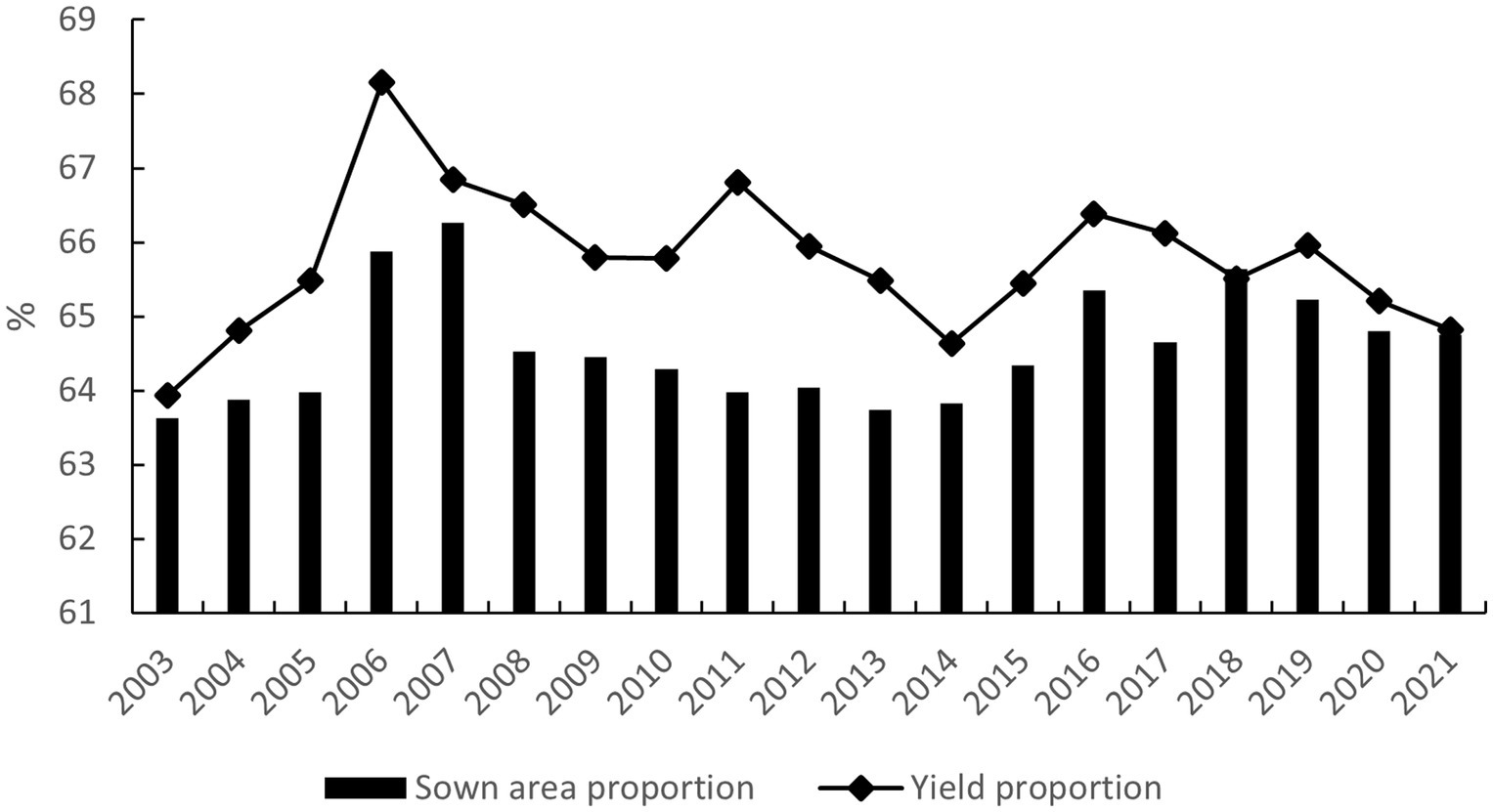
Figure 3. The proportion of maize sown area and total output in the sample area to the national total from 2003 to 2021.
3.3 Descriptive statistics
Due to the unavailability of prefecture-level data on maize prices and fertilizer price indices, this study adopts provincial-level data as substitutes, following the methods of He et al. (2018) and Wang et al. (2021). Maize price data were sourced from the Compilation of Cost and Income Data for Agricultural Products in China (2003–2020) and adjusted for inflation using the Consumer Price Index (CPI) to eliminate the effects of price changes. Fertilizer price index data were obtained from the China Statistical Abstract (2003–2018) and provincial statistical yearbooks for 2018 and 2019. Milk production data (used as an instrumental variable) were sourced from the China Statistical Yearbook (2003–2020). Precipitation and growing degree day (GDD) data were obtained from the China Meteorological Data Sharing Service Network, with GDD measured as effective temperature data between 10°C and 32°C from April to September. Urban population density data (calculated based on the resident population) were sourced from provincial statistical yearbooks, government bulletins, and the China City Statistical Yearbook (2003–2020). Three additional indicators—effective irrigation ratio, share of agricultural output, and mechanization input level—were derived from provincial or rural statistical yearbooks (2003–2020). These indicators were calculated as follows:
Missing data for the above variables were supplemented using linear interpolation. Table 1 provides descriptive statistics for all variables.
From Figure 4, it can be observed that the unit yield of maize per hectare showed an overall increasing trend from 2003 to 2020, reaching relatively high levels, particularly between 2015 and 2018. Although there were fluctuations in 2010 and certain other years, unit yields remained stable at high levels overall. Figure 4 also indicates that maize sown areas exhibited an upward trend between 2003 and 2015, peaking in 2015. Afterward, sown areas began to decline annually but remained at relatively high levels overall.
4 Empirical results and analysis
4.1 Regression analysis of price and precipitation in the yield model
In Table 2, column (1) presents regression results without control variables, column (2) adds control variables but excludes precipitation variables, and column (3) incorporates price variables, precipitation variables, and control variables simultaneously, all while controlling for the time trend and its squared term. The statistical tests indicate that the model is robust and the instrumental variables are valid. The Kleibergen-Paap test and Wald F-test rule out concerns regarding weak instruments, while the high p-value of the Hansen J test suggests that the instruments are not significantly correlated with the error term. Overall, the estimation results are consistent with agricultural economics theory, emphasizing the significant impacts of prices and precipitation on maize yield.
4.1.1 Price factors
The regression results show that the previous year’s maize price exerts a significant positive effect on current-year yield, significant at the 1% level. Price increases send a strong market signal to farmers, incentivizing them to enhance input levels and optimize management practices, thereby increasing yield per unit area. Specifically, farmers respond by increasing fertilizer and pesticide use, improving fertilization, irrigation, and pest control practices; they also actively adopt high-quality seeds, stress-resistant new varieties, and modern machinery to boost production efficiency. Fertile lands are prioritized for maize cultivation, and land consolidation and improvement are simultaneously advanced. Price increases also stimulate the involvement of cooperatives and large-scale agribusinesses, introducing scientific management and advanced technologies that further enhance yields. Price incentives operate through multiple channels—input expansion, technology adoption, resource optimization, and capital involvement—to drive improvements in maize yield.
The regression also shows that the previous year’s fertilizer price index exerts a significant positive effect on current-year maize yield, also significant at the 1% level. Rising fertilizer prices prompt farmers to apply fertilizers more efficiently, reflecting an overuse phenomenon in fertilizer application. A moderate reduction in fertilizer use can actually benefit crop growth, particularly for crops like soybeans with strong nitrogen-fixing capabilities and lower fertilizer dependence. Moreover, facing rising production costs, farmers tend to adopt high-efficiency seeds, drip irrigation, and other modern technologies or shift toward using biofertilizers and organic fertilizers, improving soil quality and crop resilience. Government interventions, such as subsidy programs and promotion of efficient fertilization technologies, further optimize fertilizer use. To hedge against risks, farmers also tend to increase investments in irrigation, seeds, and pest management, comprehensively improving their management level. Taken together, farmers’ spontaneous adjustments, technological advancements, input substitution, and policy support jointly contribute to improvements in maize yield per unit area.
4.1.2 Precipitation factors
Regarding precipitation factors, April and September precipitation have significant negative effects on maize yield, both significant at the 1% level, while July and August precipitation have significant positive effects, significant at the 1 and 5% levels, respectively. Precipitation in May and June is found to have no significant impact.
Specifically, excessive precipitation in April negatively affects yield. As this period corresponds to sowing and seedling emergence, excess rainfall can cause waterlogging, soil compaction, hinder seedling growth, and increase disease risks, ultimately weakening plant vigor and reducing yield. Precipitation in May and June does not significantly affect yield, as maize plants at the seedling and jointing stages have relatively low water requirements and strong root adaptability, and growth during this period relies more heavily on sunlight and nutrients. Regional differences and agricultural management practices further attenuate the effects of precipitation in these months. In July, precipitation positively promotes yield. During the silking and pollination stages, water demand peaks, and sufficient rainfall alleviates heat stress, enhances pollination success, improves nutrient uptake, and lays the foundation for successful grain filling. In August, continued precipitation sustains photosynthetic efficiency and kernel filling during the grain-filling stage, contributing to increases in thousand-kernel weight. Conversely, excessive rainfall in September negatively affects yield during the maturity and harvesting period by causing disease outbreaks, deteriorating grain quality, and increasing harvest losses due to waterlogging.
4.1.3 Control variables
Urban population density and mechanization level exhibit significant negative effects on maize yield, both significant at the 1% level, while effective irrigation ratio and industrial structure have significant positive effects, significant at the 1 and 10% levels, respectively.
Urban population density negatively affects yield. Urban expansion and population growth result in the encroachment of high-quality farmland, forcing maize cultivation onto marginal lands. Rural labor outmigration reduces the precision of field management, and environmental pressures such as soil pollution further weaken production potential. The effective irrigation ratio positively contributes to yield. During critical growth stages requiring high water availability, irrigation infrastructure compensates for insufficient rainfall. Technologies such as drip and sprinkler irrigation enhance water-use efficiency, optimize root development, and support kernel filling, particularly in regions with water scarcity. Industrial structure also exerts a positive impact. In regions with higher agricultural shares, more infrastructure investment and policy support are directed toward agriculture, and farmers who depend more heavily on agriculture are more proactive in adopting advanced technologies and management practices, thereby enhancing production efficiency. Conversely, mechanization input levels negatively affect yield. In some areas, mismatches between machinery and plot conditions can cause soil compaction, inhibiting root development; insufficient precision in mechanized operations may also reduce the quality of field management.
4.1.4 Time trend analysis
The linear time trend term is not significant, while its squared term shows a significant negative effect on maize yield, significant at the 1% level, indicating diminishing marginal returns to yield growth. Initial technological advances—such as mechanization, improved seeds, and better management—significantly boosted efficiency. However, as these technologies became widespread, the marginal benefits to yield growth have declined. Climate change, resource competition, and policy adjustments have further constrained yield growth potential. Looking forward, continuous innovation and efficient application of agricultural technologies, along with optimized resource allocation, are necessary to maintain production stability.
4.2 Regression analysis of price and precipitation in the planting area model
In Table 3, column (1) presents regression results without control variables, column (2) includes control variables but excludes precipitation variables, and column (3) incorporates price variables, precipitation variables, and control variables simultaneously. All three regressions control for the time trend and its squared term. Statistical tests demonstrate that the model is robust and that the instrumental variables are valid. The Kleibergen-Paap test and Wald F-test confirm that weak instruments are not a concern, and the high p-value from the Hansen J test validates the exogeneity of the instruments. Overall, the model performance aligns with agricultural economics theory.
4.2.1 Price factors
The previous year’s maize price exhibits a significant negative effect on the current-year maize planting area, significant at the 1% level. Several mechanisms may explain this relationship: government interventions, such as adjusting subsidies or promoting alternative crops, aim to stabilize markets during periods of maize price increases; rising input costs associated with price increases weaken planting incentives; and returns from substitute crops (e.g., sorghum, soybeans) become more attractive, leading to crop switching. Combined effects of policy intervention and substitution dynamics result in a decline in maize planting area.
Conversely, the previous year’s fertilizer price index shows a significant positive effect on the current-year maize planting area, significant at the 1% level. Against a backdrop of rising fertilizer prices, the government typically increases subsidy support for staple crops, particularly maize, to encourage planting. The relatively stable market price of maize reduces farmers’ production risks. Farmers in major maize-producing areas have rich experience and well-developed infrastructure, and maize’s high level of mechanization helps mitigate cost pressures. Furthermore, maize’s high responsiveness to fertilizer input and favorable input–output ratio make it a preferred crop during periods of high fertilizer costs. These factors collectively drive the expansion of maize planting area.
4.2.2 Precipitation factors
Regarding precipitation, March precipitation exerts a significant negative effect on maize planting area, while April precipitation has a significant positive effect, both at the 1% level. May precipitation shows a positive but statistically insignificant effect. Excessive precipitation in March causes soil over-saturation, delays in mechanical fieldwork and sowing, and reduces seedling emergence uniformity and growth coordination, leading farmers to reduce planting areas. In contrast, moderate April precipitation improves soil moisture, promotes seed germination and seedling growth, reduces drought risks, and increases sowing success rates and planting area. Although May precipitation positively influences localized seedling growth, overall water demand during this period is low, and irrigation can compensate for water deficits, resulting in an insignificant impact on planting area.
4.2.3 Control variables
Urban population density and effective irrigation ratio both exhibit significant negative effects on maize planting area, significant at the 1 and 5% levels, respectively, while mechanization input shows a significant positive effect at the 5% level. Industrial structure exerts a positive but statistically insignificant effect. Urbanization leads to the occupation of high-quality arable land and a loss of agricultural labor, causing a dual pressure that reduces maize planting area. In regions with high irrigation coverage, farmers tend to shift toward high-value crops such as rice and vegetables, and competition with industrial and urban land use further compresses maize cultivation. The positive but insignificant effect of industrial structure suggests that regions with a higher agricultural share may benefit from policy support and resource reallocation, which could potentially promote maize cultivation. Mechanization enhances production efficiency and reduces labor demand, thereby supporting the expansion of maize planting areas, particularly in regions facing labor shortages.
4.2.4 Time trend term
The time trend term and its quadratic term are both significant at the 1% level, with the time trend term being positive and the quadratic term being negative. The estimation results indicate that maize planting areas increase over time, but the growth rate gradually slows. This trend may reflect the sustained progress of agricultural technology and policy support for maize cultivation, such as the promotion of high-quality seeds, mechanization, and improved infrastructure. However, as these technologies become widely adopted and policy benefits are gradually realized, their marginal effects may diminish. Additionally, the optimization of cropping structures (e.g., reallocating land resources to more efficient crops) may also stabilize the growth of maize planting areas.
4.3 Robustness tests
4.3.1 Changing regression methods
Tables 2, 3 show that in the estimated results of the maize planting area and yield models, the signs and coefficients of the core explanatory variables remain consistent across different groups of explanatory variables, verifying the reliability and robustness of the models. To ensure the robustness of the findings, this study conducts robustness tests using alternative regression methods, exclusion of outliers, and substitution of dependent variables.
As shown in Tables 4, 5, even when the GMM method is not used, the instrumental variables for the planting area and yield models still pass under identification, weak instrument, and overidentification tests, indicating the rationality of the instrument variable selection. While minor changes in the significance of some variables are observed, these changes have negligible impact on the overall findings, as the significance and direction of the remaining variables remain stable. Moreover, the coefficients of the explanatory variables are largely consistent with the GMM estimation results. Specifically, maize prices show a significant positive effect on yields and a significant negative effect on planting areas, with these impacts remaining unchanged, further underscoring the critical role of price fluctuations in farmers’ planting decisions. Similarly, the fertilizer price index demonstrates significant positive effects in both the planting area and yield models, verifying the importance of resource optimization in increasing maize planting areas and yields. Overall, the results from alternative regression methods are consistent with the main model, further confirming the robustness of the findings.
4.3.2 Considering the impact of extreme values
Data anomalies are a common issue in large-sample data analysis and are an important factor affecting the robustness of regression results (Chen and Su, 2022). To prevent outliers and extreme values from distorting the findings, all continuous variables in this study were winsorized at the 1% and 99% levels, and the GMM regressions were re-estimated accordingly. Table 6 presents the regression results for both the maize yield model and the maize planting area model after winsorization. After excluding extreme values, the estimated directions and significance levels of the core explanatory variables remain largely consistent with those of the baseline model, and the regression results for the precipitation variables also align closely with the baseline findings. In this regression, the estimated directions and significance levels of the other control variables similarly show no substantial changes. Overall, the results after excluding extreme values are highly consistent with the baseline model, verifying the robustness of the study’s conclusions and further supporting the theoretical framework that maize production is jointly influenced by price and precipitation dynamics.
4.3.3 Substituting the dependent variable
To further verify the robustness of the planting area model, this study replaces maize planting area with total output as the dependent variable. The results in Table 7 indicate that the regression results after substituting the dependent variable are consistent with those of the planting area model, confirming the robustness of the findings. This suggests that the empirical framework for analyzing the combined effects of price and precipitation on maize production has strong applicability.
5 Conclusion and discussion
5.1 Conclusion
Based on panel data from 116 prefecture-level cities in China from 2003 to 2019, this study employs fixed effects models and GMM estimation methods to analyze the impacts of prices and precipitation on maize yield and planting area, and verifies the robustness of the results. The findings show that an increase in the previous year’s maize price significantly improves the current-year yield, but planting area declines due to policy interventions, rising production costs, and intensified competition from substitute crops. An increase in the fertilizer price index has a positive effect on yield, suggesting that farmers respond to cost pressures through precision fertilization and technological innovation; fertilizer price increases also expand planting areas. The effects of precipitation exhibit notable monthly variations: precipitation in April and September reduces yield, whereas precipitation in July and August significantly enhances yield. Excessive precipitation in March reduces planting area by affecting sowing efficiency, while moderate precipitation in April improves soil moisture conditions, thereby increasing planting area. Analysis of control variables shows that urbanization rate and effective irrigation ratio are negatively correlated with maize production, while mechanization levels significantly promote the expansion of planting area. The observed time trends indicate a slowdown in the growth rates of both yield and planting area, reflecting diminishing marginal returns to technological progress and the ongoing impacts of climate change.
5.2 Discussion
Maize prices, fertilizer prices, and precipitation fluctuations jointly affect planting area and yield, reflecting the adaptive challenges faced by food production systems in response to market and climate variability. Although maize price increases promote yield, they also lead to contractions in planting area due to rising production costs and increased competition from substitute crops—patterns observed not only in Northeast China and the Huang-Huai-Hai region but also in the U.S. Midwest and Argentina’s Pampas region. Fertilizer price increases incentivize farmers to optimize input use, resulting in improvements in both yield and planting area, yet they also heighten decision-making uncertainty.
Precipitation variability demonstrates stage-specific effects: adequate rainfall during the silking and grain-filling stages enhances yield, while extreme precipitation during sowing or maturity stages suppresses planting area expansion and final harvest outcomes. Similar phenomena are observed in the cultivation of rice, soybeans, and wheat. Urbanization erodes arable land and labor resources; while improved mechanization supports planting area expansion, mismatches in some regions may increase yield risks.
The interaction between price and climate variability further complicates farmers’ decision-making processes, necessitating greater resilience within production systems. This study not only reveals the mechanisms of maize production in China but also provides insights into how global food systems can respond to market and climate shocks, emphasizing the need to strengthen comparative and innovative research on agricultural adaptation mechanisms across multiple crops, regions, and scenarios to support sustainable food system development and ensure food security.
5.3 Research limitations and future directions
This study, based on panel data from 116 prefecture-level cities in China from 2003 to 2019, employs fixed effects models and GMM estimation to analyze the combined impacts of prices and precipitation on maize yield and planting area and confirms the robustness of the findings. However, several limitations remain. First, the climate analysis considers only precipitation and does not account for the effects of temperature or extreme weather events (e.g., droughts, floods) on maize growth. For example, high-temperature stress during the silking stage or extreme rainfall events could significantly affect yield but are not incorporated into the current analysis. Second, panel data at the prefecture-level do not capture farm-level heterogeneity, potentially neglecting the influence of factors such as social networks, risk preferences, and technology adoption on decision-making, which may lead to deviations between theoretical analysis and practical outcomes. Third, the sample covers the period 2003–2019 and does not reflect the most recent policy changes and climate trends. Although the sample includes 116 cities across nine provinces, covering approximately 85% of China’s main maize production areas, its limited national coverage may constrain the generalizability of the conclusions.
Future research could improve in the following areas:
First, by incorporating multidimensional climate indicators (e.g., temperature, extreme events, soil moisture) and employing dynamic panel models or quantile regression methods to assess the differentiated impacts of climate change on maize production.
Second, through micro-level farmer surveys, behavioral economics approaches could be used to analyze how social networks, technology adoption, and risk preferences influence production decisions, thus enriching the analysis of the price–climate mechanism.
Third, randomized controlled trials (RCTs) or quasi-experimental methods (e.g., regression discontinuity design, propensity score matching) could be adopted to rigorously assess the actual effects of policy interventions such as price support programs or irrigation promotion.
Fourth, the integration of remote sensing and GIS technologies could enable real-time monitoring of planting patterns, and crop models could be used to simulate production changes under various climate and management scenarios.
Data availability statement
The original contributions presented in the study are included in the article/supplementary material, further inquiries can be directed to the corresponding authors.
Author contributions
WH: Conceptualization, Data curation, Investigation, Methodology, Software, Visualization, Writing – original draft. YC: Conceptualization, Investigation, Methodology, Project administration, Writing – original draft. XH: Investigation, Supervision, Validation, Writing – original draft. ZZ: Conceptualization, Validation, Writing – original draft. MC: Conceptualization, Investigation, Methodology, Visualization, Writing – original draft. HZ: Conceptualization, Methodology, Visualization, Writing – original draft. CJ: Conceptualization, Investigation, Software, Visualization, Writing – original draft.
Funding
The author(s) declare that financial support was received for the research and/or publication of this article. This research was supported by the following projects: the “Supporting Scheme for MSMEs by Building Sustainable Agricultural Fresh Food Production and Logistics in China (NO.ACA/2021/428467)” funded by the European Union (the contents of this publication do not necessarily reflect the views of the European Union); the Agricultural Science and Technology Innovation Program (10-IAED-01-2025); and the “Central Public-interest Scientific Institution Basal Research Funds (NO.Y2025YC63)”. The authors gratefully acknowledge this support.
Conflict of interest
The authors declare that the research was conducted in the absence of any commercial or financial relationships that could be construed as a potential conflict of interest.
Generative AI statement
The author(s) declare that no Gen AI was used in the creation of this manuscript.
Correction note
A correction has been made to this article. Details can be found at: 10.3389/fsufs.2025.1645144.
Publisher’s note
All claims expressed in this article are solely those of the authors and do not necessarily represent those of their affiliated organizations, or those of the publisher, the editors and the reviewers. Any product that may be evaluated in this article, or claim that may be made by its manufacturer, is not guaranteed or endorsed by the publisher.
References
Adeagbo, O., Ojo, T., and Adetoro, A. (2021). Understanding the determinants of climate change adaptation strategies among smallholder maize farmers in south-west, Nigeria. Heliyon 7:e06231. doi: 10.1016/j.heliyon.2021.e06231
Cairns, J., Hellin, J., Sonder, K., Araus, J., MacRobert, J., Thierfelder, C., et al. (2013). Adapting maize production to climate change in sub-Saharan Africa. Food Security. 5, 345–360. doi: 10.1007/s12571-013-0256-x
Chavas, J. P., and Holt, M. (1990). Acreage decisions under risk: the case of maize and soybeans. Am. J. Agric. Econ. 72, 529–538. doi: 10.2307/1243021
Chembezi, D. M., and Womack, A. W. (1992). Regional acreage response for US maize and wheat: the effects of government programs. South. J. Agric. Econ. 24, 1–12.
Chen, Q. (2014). Advanced econometrics and Stata applications (2nd edition). Beijing: Higher Education Press.
Chen, J., and Su, L. (2022). "Tax reform", source mobility, and equity in basic education. J Central China Normal Univ 61, 162–174.
Chen, W., and Zhou, S. (2022). Effects of precipitation during different growth stages on summer maize output. J South China Agricult Univ 21, 91–103. doi: 10.7671/j.issn.1672-0202.2022.04.009
Choi, J. S., and Helmberger, P. G. (1993). How sensitive are crop yields to price changes and farm programs? J. Agric. Appl. Econ. 25, 237–244. doi: 10.1017/S1074070800018794
Cui, J., Wang, X., and Xin, X. (2011). Effects of growing season climate change on the yield of major grain crops in China. China Rural Econ 9, 13–22.
Darwin, R. (1999). A farmer's view of the Ricardian approach to measuring agricultural effects of climatic change. Clim. Chang. 41, 371–411. doi: 10.1023/A:1005421707801
Fang, Y., and Yang, M. (2016). Study on the response of maize supply to prices in different regions of China. Price Theory Pract 5, 119–122. doi: 10.19851/j.cnki.cn11-1010/f.2016.05.030
Gao, S. (1991). The impact of greenhouse effect on climate and agriculture. Beijing: Meteorological Press.
Ge, Y., Liu, L., Xu, X., Zhang, X., Yuan, L., and Zhang, X. (2015). Spatiotemporal evolution of maize production potential in China under climate change over the past 50 years. J. Nat. Resour. 30, 784–795. doi: 10.11849/zrzyxb.2015.05.007
Geng, Y., and Gao, Q. (2021). Research on the fluctuation law of maize supply and its response to price in Shandong Province. Price Monthly 8, 18–25. doi: 10.14076/j.issn.1006-2025.2021.08.03
He, C., Yu, L., and Jiang, X. (2018). The impact of target price reform on cotton planting area: an analysis based on county-level panel data and difference-in-differences method. Price Theory Pract 10, 61–64. doi: 10.19851/j.cnki.cn11-1010/f.2018.10.016
Houck, J. P., and Gallagher, P. W. (1976). The price responsiveness of U.S. maize yields. Am. J. Agric. Econ. 58, 731–734. doi: 10.2307/1238817
Jin, Z. (1991). Simulation study on the impact of global climate change on China's grain production. Nanjing, Jiangsu, China: Nanjing Agricultural University.
Kaufmann, R. K., and Snell, S. E. (1997). A biophysical model of maize yield: integrating climatic and social determinants. Am. J. Agric. Econ. 79, 178–190. doi: 10.2307/1243952
Li, W., Hu, H., Li, S., and Xia, L. (2018). Social activities and health promotion for the elderly: evidence from tracking data from 2005 to 2014. Population Dev 24, 90–100.
Lin, E., Zhang, H., and Wang, J. (1997). Simulation of the impact of global climate change on China's agriculture. Beijing: China Agricultural Press.
Liu, Y., and Liu, D. (2023). Gains and losses of maize storage system reform and implications. Iss Agricult Econ 6, 86–96. doi: 10.13246/j.cnki.iae.2023.06.008
Lü, X., and Li, X. (2020). Analysis of maize supply-demand situation, price, and farmers' income fluctuation trends. Gansu Soc Sci 1, 120–126. doi: 10.15891/j.cnki.cn62-1093/c.2020.01.049
Lyons, D. C., and Thompson, R. L. (1981). The effect of distortions in relative prices on maize productivity and exports: a cross-country study. J Rural Dev Nongchon-Gyeongje 4, 83–102.
Ma, J., Kong, W., and Chen, Y. (2015). Empirical analysis of the impact of climate factors on maize yield: based on data from farmers in Hebei Province. J Agrotechn Econ 4, 19–25. doi: 10.13246/j.cnki.jae.2015.04.003
Mao, X., Yin, S., and Liu, H. (2022). Response of maize yield to climate change in North China from 1960 to 2020. J Arid Land Resourc Environ 36, 193–200. doi: 10.13448/j.cnki.jalre.2022.267
Mendelsohn, R., Nordhaus, W. D., and Shaw, D. (1994). The impact of global warming on agriculture: a Ricardian analysis. Am. Econ. Rev. 84, 753–771.
Menz, K. M., and Pardey, P. (1983). Technology and U.S. maize yields: plateaus and Price responsiveness. Am. J. Agric. Econ. 65, 558–562. doi: 10.2307/1240505
Miao, R., Khanna, M., and Huang, H. (2016). Responsiveness of crop yield and acreage to prices and climate. Am. J. Agric. Econ. 98, 191–211. doi: 10.1093/ajae/aav025
Miller, D. J., and Plantinga, A. J. (1999). Modeling land use decisions with aggregate data. Am. J. Agric. Econ. 81, 180–194. doi: 10.2307/1244459
Qian, W., and Wang, D. (2015). How to stabilize China's maize supply: an empirical analysis based on interprovincial dynamic panel data. J Agrotechn Econ 1, 22–32. doi: 10.13246/j.cnki.jae.2015.01.003
Qian, F., Wang, W., and Liu, Y. (2014). Adaptation measures and countermeasures in the agricultural sector to address climate change. China Popul. Resour. Environ. 12, 283–289. doi: 10.1080/10042857.2014.928984
Qiao, H. (2017). Response of peanut farmers' production decision-making to prices. Nanjing, Jiangsu, China: Nanjing Agricultural University.
Ray, D., Gerber, J., Mac Donald, G., and West, P. (2015). Climate variation explains a third of global crop yield variability. Nat Commun 6:6989. doi: 10.1038/ncomms6989
Schlenker, W., and Roberts, M. J. (2009). Nonlinear temperature effects indicate severe damages to US crop yields under climate change. Proc. Natl. Acad. Sci. 106, 15594–15598. doi: 10.1073/pnas.0906865106
Si, R., Tan, Y., and Liu, M. (2025). Interaction between high-quality development and high-level security in the livestock industry: theoretical logic, practical barriers, and solution paths. Iss Agricult Econ, 1–17. doi: 10.13246/j.cnki.iae.20241119.001
Si, W., and Wang, X. (2006). Supply response of sugar crops in China. China Rural Observ 4, 2–11+55. doi: 10.20074/j.cnki.11-3586/f.2006.04.001
Song, Y., Tian, J., Linderholm, H., Wang, C., Zhao-rong, O., and Chen, D. (2020). The contributions of climate change and production area expansion to drought risk for maize in China over the last four decades. Int. J. Climatol. 41:6885. doi: 10.1002/joc.6885
Song, H., and Wei, J. (2024). Strengthening national food supply security in all dimensions. Zhongzhou Acad J 2:5-13+2.
Su, X. (2024). Maize migration mitigates the negative impact of climate change on China’s maize yield. Environ. Res. Lett. 19:074058. doi: 10.1088/1748-9326/ad5bf3
Tong, X., Hu, D., and Yang, X. (2019). Evaluation of the effects of minimum purchase price policies for grain: a case study of wheat. Iss Agricult Econ 9, 85–95. doi: 10.13246/j.cnki.iae.2019.09.010
Wang, Y. (2014). Supply response model of rice in China. Hangzhou, Zhejiang, China: Zhejiang University.
Wang, C. (2018). Research on China's food supply response. Beijing, China: Chinese Academy of Agricultural Sciences.
Wang, J. (2021). Research on maize price volatility and its effects in China. Baoding, Hebei, China: Hebei Agricultural University.
Wang, H., Li, G., and Hu, Y. (2024). Research on the stability mechanism of maize production under the reform of storage system marketization and uncertainty of returns: an empirical analysis based on 247 prefecture-level cities in maize-producing areas. J Agrotechn Econ 6, 124–144. doi: 10.13246/j.cnki.jae.2024.06.005
Wang, F., Qin, J., and Shi, Z. (2021). Analysis of China's major agricultural product import strategy under the new development pattern. China Agricult Resourc Region Plan 42, 127–137.
Wang, K., Xue, J., Sun, L., and Li, S. (2022). Comparison and analysis of maize grain commodity quality and mechanical harvest quality between China and the United States. Int J Agricult Biol Engineer 15, 55–61. doi: 10.25165/j.ijabe.20221501.6099
Xiao, G., Wang, Y., and Gong, B. (2017). Correlation between international grain prices and the fluctuation of China's grain production. Fin Pract 38, 115–120. doi: 10.16339/j.cnki.hdxbcjb.2017.04.019
Ye, X., Cheng, Y., and Zhang, X. (2024). Changes in supply and demand trends of major agricultural products in China and strategies for improving supply security. Reformation 4, 1–18.
Zhang, X. (2021). Analysis of drivers for farmers' maize planting area adjustment decisions. Shenyang, Liaoning, China: Shenyang Agricultural University.
Zhao, C., Liu, B., Piao, S., Wang, X., Lobell, D., Huang, Y., et al. (2017). Temperature increase reduces global yields of major crops in four independent estimates. Proc. Natl. Acad. Sci. 114, 9326–9331. doi: 10.1073/pnas.1701762114
Keywords: maize production, maize price fluctuations, fertilizer price index, precipitation impacts, agricultural policy
Citation: Hao W, Cao Y, Hu X, Zhang Z, Cai M, Zhou H and Jiang C (2025) Analysis of the impact of price incentives and precipitation fluctuations on maize planting area and yield. Front. Sustain. Food Syst. 9:1587677. doi: 10.3389/fsufs.2025.1587677
Edited by:
Niaz Ali, Hazara University, PakistanReviewed by:
Wang Gangyi, Northeast Agricultural University, ChinaOrachos Napasintuwong, Kasetsart University, Thailand
Copyright © 2025 Hao, Cao, Hu, Zhang, Cai, Zhou and Jiang. This is an open-access article distributed under the terms of the Creative Commons Attribution License (CC BY). The use, distribution or reproduction in other forums is permitted, provided the original author(s) and the copyright owner(s) are credited and that the original publication in this journal is cited, in accordance with accepted academic practice. No use, distribution or reproduction is permitted which does not comply with these terms.
*Correspondence: Hui Zhou, emhvdWh1aUBjYWFzLmNu; Changyi Jiang, ODIxMDEyMzEzODhAY2Fhcy5jbg==
†These authors share first authorship
 Wang Hao
Wang Hao Yan Cao1†
Yan Cao1† Xiangdong Hu
Xiangdong Hu